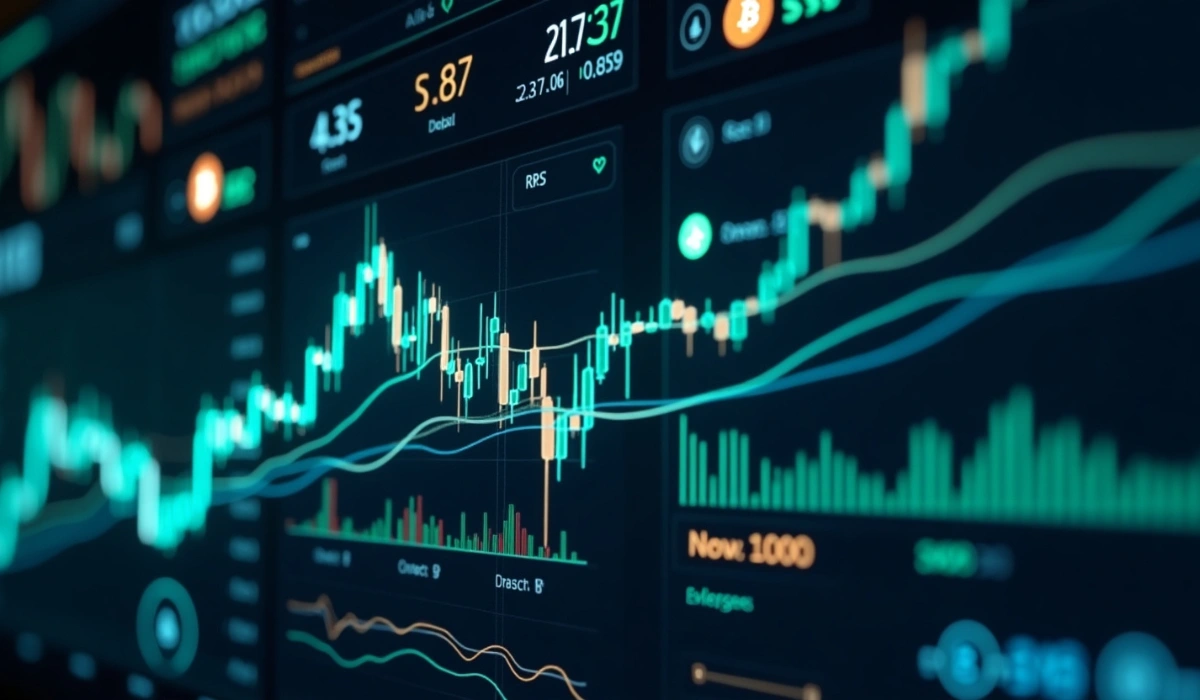In the crypto market, traders use various indicators that observe the charts to identify potential buying and selling opportunities. A wide variety of complex trading tactics have emerged as a result of the cryptocurrency market’s recurring exhibition of extreme volatility and quick trend changes.
Traders use technical indicators, tools that examine price fluctuations, volume, and market trends, to navigate this highly fluctuating environment. These indicators assist traders in seeing trends early, avoiding costly errors, and identifying possible buying and selling opportunities.
In this article, we will dive into five indicators that can help or compete with the emerging automated trading systems: MACD, RIS, Stochastic Oscillator, Bollinger Bands, and Ichimoku. Let’s get started.
1. Moving Average Convergence Divergence (MACD)

MACD is a technical indicator used to detect changes in the strength, direction, momentum, and duration of an asset’s trends.
It was developed in the late 1970s by Gerald Appel, a market analyst and author. The effectiveness of the technique made it one of the most popular indicators in the crypto industry.
How to Use MACD?
MACD has three measurements to note: MACD line, the difference between 12-period EMA and 26-period EMA, Signal Line, a 9-period EMA, and Histogram, the graphical representation of the comparison of MACD and Signal lines.
If the MACD line moves above the Signal line, the market is considered to be bullish. An exact opposite scenario is a bearish signal. If the value of an asset makes a new high but there is no significant uptrend in MACD, it could result in a reversal.
How is MACD Calculated?
MACD is calculated by subtracting the long-term estimated moving average (EMA), usually 26 periods, from the short-term EMA (12 periods). That is:
- MACD=12-Period EMA − 26-Period EMA
- 12-Period EMA = A 12-period Exponential Moving Average is a short-term EMA.
- 26-Period EMA = A 26-period Exponential Moving Average is a long-term average.
- If BTC’s 12-period EMA is 100,000 and the 26-period EMA is $88,000, then the MACD is:
- MACD = 100,000 – 88,000 = 12,000.
2. Relative Strength Index (RSI)
RSI is a technical indicator that measures the speed and change of price movements, identifying the historical and current strengths and weaknesses of assets.
J. Wells Wilder Jr., an American mechanical engineer and author, introduced this indicator to the world through his book “New Concepts in Technical Trading Systems” in 1978.
How to Use RSI?
RSI is denoted by a line-graph oscillator that travels between 0 and 100. If it is above 70, the asset could be overvalued, and a sudden price correction might happen.
If it is below 30, the asset is undervalued and oversold, on the verge of experiencing a price increase.
Usually, crypto traders who follow RSI tend to sell their assets when they go above 70 and buy when they drop below 30. If RSI didn’t witness an uptrend according to the asset price, it could trigger a possible reversal.
Also, generally, traders put 50 as a mark where below 50 signals bear phase and above 50 signals bull phase.
How to Calculate RSI?
The popular formula to calculate RSI is:
RSI = 100 – [100 ÷ ( 1 + (Average Gain During Up Periods ÷ Average Loss During Down Periods ))]
Average Gain = [(Past Average Gain) x 13 + Current Gain] ÷ 14
Average Loss = [(Past Average Loss) x 13 + Current Loss] ÷ 14
3. Stochastic Oscillator (SO)
SO is a technical indicator that analyzes an asset’s high and low prices to find overbought and oversold signals. Its value ranges between 0 and 100, in which values above 80 suggest that the asset is overbought, and values below 20 suggest that it is oversold.
Users can identify these zones using two lines: the %K line, the current closing price in relation to the range over a given period, and the %D line, a slower indicator of the same.
How to Calculate the Stochastic Oscillator?
SO can be calculated using the formula:
- %K = (C−L14 / H14−L14) × 100
- C = The most recent closing price
- L14 = It is the lowest value of the asset within the last 14 days
- H14 = It is the highest value of the asset within the last 14 trading sessions.
4. Bollinger Bands
Based on a formulaic method propounded by the American author and financial analyst John Bollinger, Bollinger Bands allow traders to detect potential areas of support and resistance.
How to Calculate & Use Bollinger Bands?
The major measurements are upper, middle, and lower bands. If the value of the asset reaches the upper band, it may be overbought. If it reaches the lower band, it is oversold.
- Middle Band: It is the 20-day simple moving average (SMA)
- Upper Band: 20-day SMA + (20-day SD x 2)
- Lower Band: 20-day SMA – (20-day SD x 2)
SD = Standard Deviation. To find it, calculate the average price of the period (here, 20 days). Then, calculate the variance by subtracting the average from the closing price. Finally, find the variance’s square to reveal the SD.
5. Ichimoku
Ichimoku Kinko Hyo (IKH), shortened as Ichimoku, is a moving average-driven technical analysis tool that can help traders identify trends. The developer of this technique, Goichi Hosoda, spent 30 years perfecting it before releasing it to the public in the 1960s. It has five components:
- Tenkan-sen (conversion line): It can be used to understand reversals. To calculate, add the highest high and the lowest low over the past nine periods and then divide the result by two.
- Kijun-sen (base line): mainly used as a trailing stop-loss limit. Calculated by adding the 26-period highest high and the lowest low and dividing the result by two.
- Senkou Span A (leading span A): It is used to predict upcoming support and resistance. Calculated by adding the tenkan-sen and the kijun-sen, dividing the result by two, and then plotting the result 26 periods ahead.
- Senkou Span B (leading span B): Used to identify futuristic support and resistance. Calculation is similar to Span A, but adds the highest high and the lowest low over the past 52 periods.
- Chikou Span (lagging span): It is the current period’s closing price plotted 26 days back on the chart, used to indicate support and resistance.
Also Read: How to Use a Crypto Hardware Wallet: A Step-by-Step Guide
Comparison Between Top 5 Trading Indicators
Here is a detailed comparison table of the above-mentioned indicators:
| Indicator | Type | Best For | Key Signals | Strength |
|---|---|---|---|---|
| MACD | Momentum, Trend-Following | Spotting trend direction & momentum shifts | Line crossovers, zero-line crossovers, divergence | Good at capturing medium to long-term trends |
| RSI | Momentum Oscillator | Identifying overbought/oversold conditions | Above 70 (overbought), below 30 (oversold), divergence | Simple and effective in spotting reversals |
| Stochastic Oscillator | Momentum Oscillator | Timing entries & exits in volatile moves | %K/%D line crossovers, over 80/under 20 levels | Very responsive, useful in range-bound markets |
| Bollinger Bands | Volatility | Detecting volatility expansions & contractions | Band squeezes, price touching bands | Adapts well to changing market conditions |
| Ichimoku Cloud | Trend, Support/Resistance | Comprehensive trend analysis | Cloud breakouts, line crossovers, cloud thickness | Offers a multi-dimensional view (trend + support) |
Additional Relevant Market Indicators List
Although the above five have been selected after considering the time we are in, there are multiple indicators worth mentioning, such as EMA, SMA, ATR, and Fibonacci Retracement Levels. Let us take a look.
- Exponential Moving Average (EMA): A moving average that gives more weight to recent prices, making it faster to respond to price changes than simple moving averages.
- Simple Moving Average (SMA): Calculates the average price over a set period, helping traders identify overall trend direction.
- Average True Range (ATR): Measures market volatility by calculating the average range between high and low prices over a period.
- Parabolic SAR (Stop and Reverse): A trend-following indicator that provides entry and exit points by placing dots above or below price candles.
- Fibonacci Retracement Levels: Horizontal lines that indicate where support and resistance are likely to occur, based on Fibonacci ratios (like 61.8%, 38.2%).
- Volume: Tracks the number of coins or tokens traded, which helps confirm the strength of price movements or trends.
- On-Balance Volume (OBV): Combines price and volume data to show whether volume is flowing in or out of an asset, helping to predict price movements.
- Chaikin Money Flow (CMF): Measures the volume-weighted average of accumulation and distribution over a specific period to detect buying or selling pressure.
- Commodity Channel Index (CCI): Identifies cyclical trends by measuring the deviation of an asset’s price from its statistical mean.
- ADX (Average Directional Index): Quantifies trend strength without indicating trend direction; an ADX above 25 suggests a strong trend, while below 20 indicates a weak trend.
Conclusion
While the above-mentioned indicators are commonly used by traders around the globe, it is important to choose the best indicator that satisfies your own unique goal. Always DYOR!




